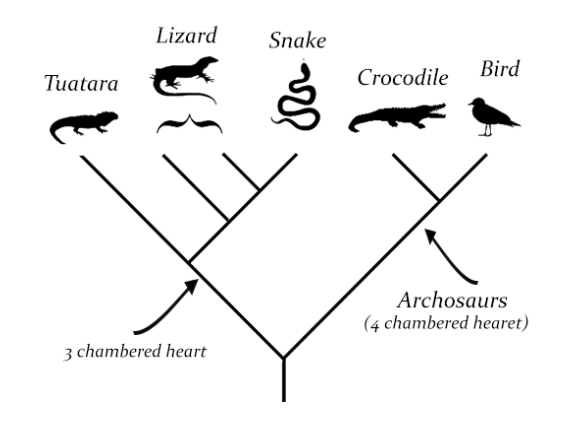What is a Cladogram?
This page is a draft and is under active development.
( \newcommand{\kernel}{\mathrm{null}\,}\)
A cladogram is a diagram that shows relationships between species. These relationships are based on observable physical characteristics. Cladograms show the relationships in a graphic that looks like a tree, with branches connected to a common ancestry. Each branch represents a new distinct trait that was not seen in the group lower on the tree. These distinct traits are called derived characteristics.
The groups on the diagram are organized into clades, each clade shares distinct traits. For example, in the cladogram shown, birds and crocodiles are grouped into a clade called archosaurs, which share characteristics such as a 4 chambered heart and socketed teeth.

1) Examine the cladogram above and suggest a trait that lizards and snakes share, but is not shared by individuals of other groups.
Activity 1: Create an Animal Cladogram
2) For each animal shown, list as many characteristics as you can. You can also include traits that aren't apparent from the photo, such as reproductive strategies or unique behaviors. Try to come up with traits that are shared by multiple animals and at least one trait that is unique for each animal.

3) Complete a characteristics chart. Place an X for features that each animal has, and a O for features not exhibited in the animal. All of these animals have backbones, the first column is completed for you.
|
Trait 1 |
Trait 2 |
Trait 3 |
Trait 4 |
Trait 5 |
|
|
Backbone |
Lungs |
Amniote Egg |
4 chambered heart |
Fur |
|
|
Fish |
X |
||||
|
Frog |
X |
||||
|
Lizard |
X |
||||
|
Bird |
X |
||||
|
Koala |
X |
4) The chart is then converted to a cladogram. Each group, called a CLADE, has the traits below it on the diagram. When a group doesn't have a trait, it is called an OUTGROUP. The first outgroup is fish, because it is the only one that doesn't have lungs.

Activity 2: Create Your Own Cladogram
Cladograms are also used to show relationships between plants, fungi, and other living organisms. A cladogram can focus on one group, like birds or dinosaurs to show relationships based on characteristics and other evidence. Now that you know how to build one, your task is to create a cladogram for a group of animals of your choice.
Examples of groups to choose from: fish, birds, insects, dinosaurs, monkeys, reptiles, canines, felines, trees, flowers.
*Choose a group that you know something about so you can create your chart based on observed traits and your own knowledge..
Requirements:
-
You must have 4 - 6 organisms
-
You must create a chart like the one in #3 which includes traits that are shared and traits that are unique
-
You must create a cladogram like the one in #4.
-
While there may not be one *correct* cladogram for your group, be prepared to defend your cladogram design

